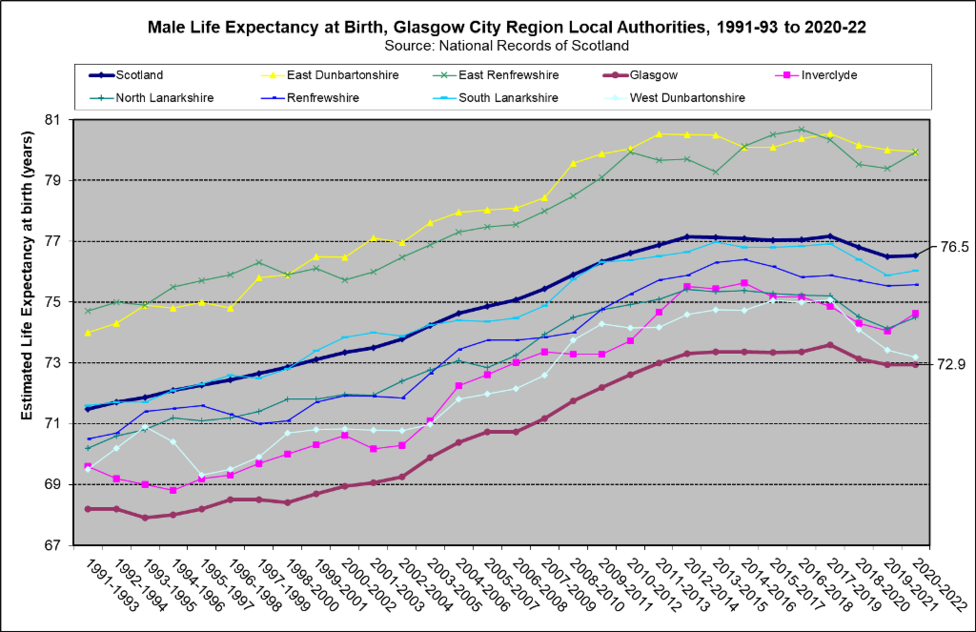Glasgow City Region
Male life expectancy, Glasgow City Region
Male life expectancy in Scotland has increased over the last 30 years. However, improvements in life expectancy stalled from 2012 onwards. This is likely to be as a consequence of UK austerity policies. From 2012-2014 to 2017-2019, there was barely any rise in male life expectancy at a Scottish level and male life expectancy started to reduce in several local authorities. Increased mortality due to the COVID-19 pandemic, which began in early 2020, has led to a further sharp reduction in life expectancy.
Male life expectancy increased overall in every local authority in the Glasgow City Region over the last 30 years. However, the graph illustrates the large inequalities in health that exist in the region. Male life expectancy in East Dunbartonshire is estimated to be seven years longer than in Glasgow.
Since 2012-2014, male life expectancy has reduced in Scotland and in seven out of the eight local authorities in the Glasgow City Region.
Female life expectancy, Glasgow City Region
Female life expectancy in Scotland has increased over the last 30 years, but, as for men, there has been a flattening off in this improvement since 2012. In the period 2012-2014 to 2017-2019, there was no improvement in female life expectancy at a national level, and female life expectancy reduced in several of the Glasgow City Region local authorities, including Glasgow and most notably in Inverclyde. In the most recent period shown, 2020-21, increased mortality due to the COVID-19 pandemic led to a further reduction in life expectancy.
The graph also illustrates the large inequalities in health that exist in the region. Female life expectancy in East Renfrewshire is estimated to be 5.8 years longer than in Glasgow.
The deteriorating relative position of West Dunbartonshire in terms of life expectancy is notable. While over the last 30 years female life expectancy in West Dunbartonshire has increased, improvements have been more modest than in other authorities and so its position has deteriorated relative to the other Glasgow City Region councils. Female life expectancy in West Dunbartonshire is now only marginally higher than in Glasgow.
Similarly, Inverclyde's relative position has also been deteriorating with estimated female life expectancy in the authority having reduced notably in the last eight years reported. Since 2012-2014, female life expectancy has reduced in Scotland and in six out of the eight local authorities in the Glasgow City Region.
Notes
The data underlying these graphs come from National Records of Scotland.
In August 2021 the GCPH published Health in a changing city: Glasgow 2021, a report that examined demographic, socio-economic, environmental and health trends in Glasgow over the last two decades and trends in life expectancy by neighbourhood and by deprivation were included.
Research on the impact of austerity on mortality and life expectancy can be accessed on the GCPH website. The most recent paper on the likely impact of UK austerity policies was published in October 2022: ‘Bearing the burden of austerity: how do changing mortality rates in the UK compare between men and women?
This page was last updated in October 2023.
